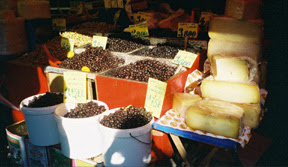Turkish Delight
My Anatolian Adventure
May, 2002
“Turkish Delight?” I said. “What’s that?’
I’d soon find out.
This was my first day in Istanbul. Arriving at my hotel in the Sultanahmet district-- the old city--I found myself in what used to be called Constantinople—the capitol of the Byzantine Empire.
I was anxious to get my first taste of the famed city, but Turkish Delight was not on my agenda. It was on Vi’s. I had traveled twice around the world with Vi, and this was to be our next adventure. Exhausted from our all-night flight from Dulles to Istanbul but not wishing to waste time, we
were ready to roll.
She was eager to scout out the best source of Turkish Delight in Istanbul. I wanted to wander through the narrow passageways of the Kapali Carsi, the notorious Grand Bazaar, or covered market. This would be my first chance to check out my bargaining skills at a few of its 4,000 shops. This bewildering array of tiny stalls jammed into a maze of 66 narrow passageways stretches some five miles in length and pulls you into it like a magnet attracted by shopping for the best bargains. Friends have told me stories of wandering, lost and exhausted, for hours before they could find their original entrance. I was counting on my so-called keen sense of direction to save the day. (Ultimately, I failed!)
Piles of pashima shawls, glittering gold and silver jewelry, elegant Turkish kilim rugs, and heaps of tee shirts emblazoned with “Istanbul” beckoned. But first we had to maneuver through a phalanx of insistent street vendors outside the bazaar entrance. They spotted us, those potential “rich American tourists” and like bees to baklava buzzed around us, pushing their wares as we headed toward the bazaar.
Vi quickly swung into action, bargaining for her prized Turkish Delight. I tested a few free bites as I checked into the origins of this traditional Ottoman candy confection called “lokum” in Turkish. It’s prepared with fillings of walnuts, pistachios, almonds or orange flavoring, and can be found everywhere in Turkey. Most often, you can nibble a free sample before you buy. And we did. Frequently.
History says that one Ali Muhiddin, its inventor, arrived in the Ottoman capitol in the late 18th century and mixed up the first batch of “locum” into a soft bite-size easy-to-chew sweet. The new tidbit was an instant hit with the palace dignitaries of the day, and success on the street wasn’t far
behind. Today, the ubiquitous Turkish Delight seems to be the national candy of choice, the Turkish counterpart to the American M&M, Hershey bar, and Orange Slice all wrapped up into one.
On my first day there, I didn’t know that --or much more-- about Anatolia—as Turkey is called in the guidebooks. But that would change before the month was over.
By the end of my journey, the term Turkish Delight meant more to me than simply a bite-size candy to satisfy my sweet tooth. It conjured up lingering memories of picnics in the shade of olive groves high in the mountains, the sweet fragrance of fields of blood- red poppies that carpet entire hillsides and pop up in unexpected places between marble steps of ancient amphitheaters, the cascades of color and taste of huge mounds of cherries, limes, eggplants, and tomatoes, and powerful aroma of fresh fish piled high in neat mountains of silver in noisy village markets, and the vibrant hues of aquamarine and periwinkle seas along the Aegean and Mediterranean coasts. Above all, it conveys my sense of delight and appreciation for the friendly greetings we received from children and generous welcome from everyone else we encountered in our short visit.
[On to Turkey Part Three]



